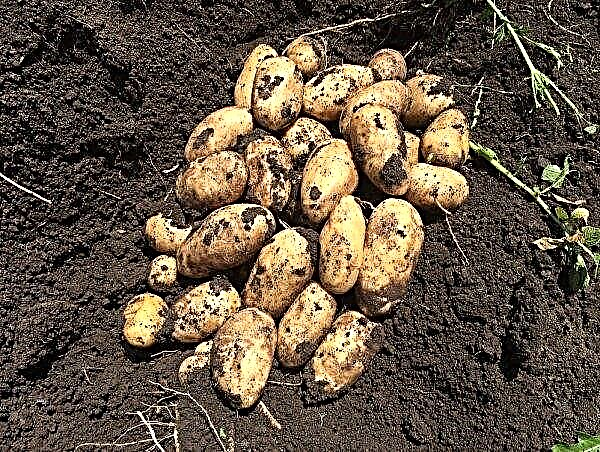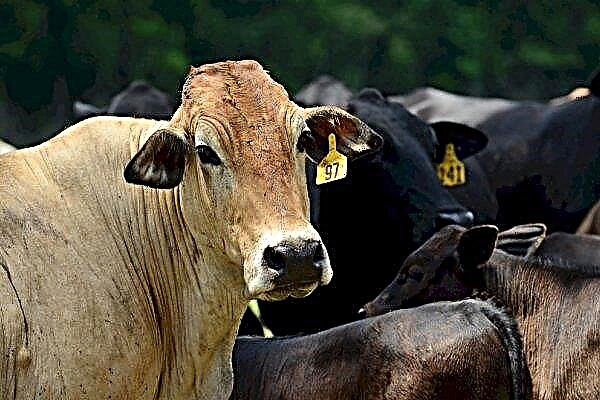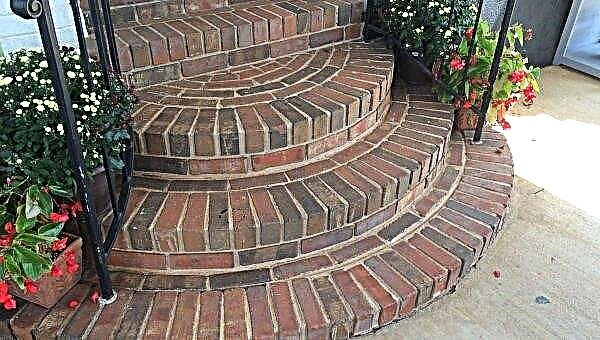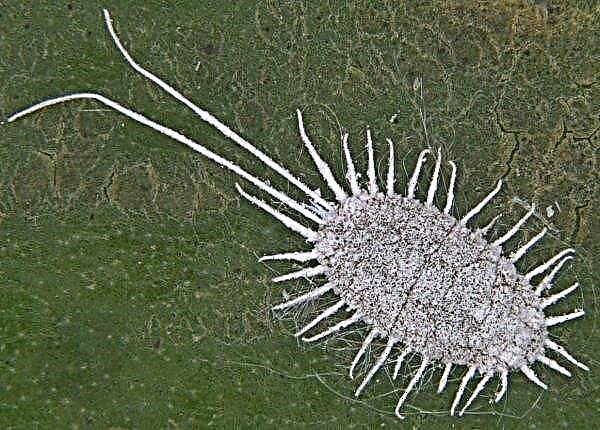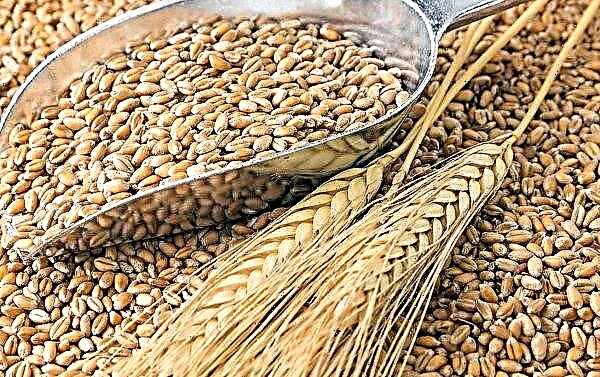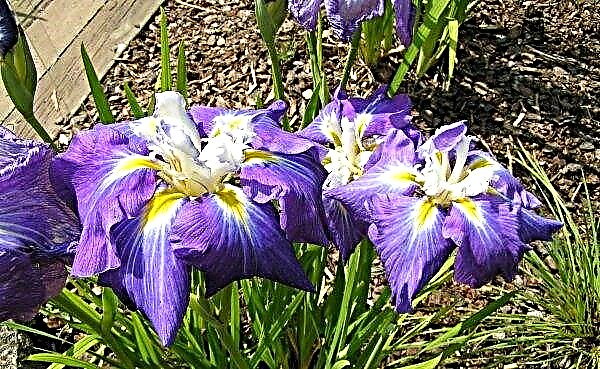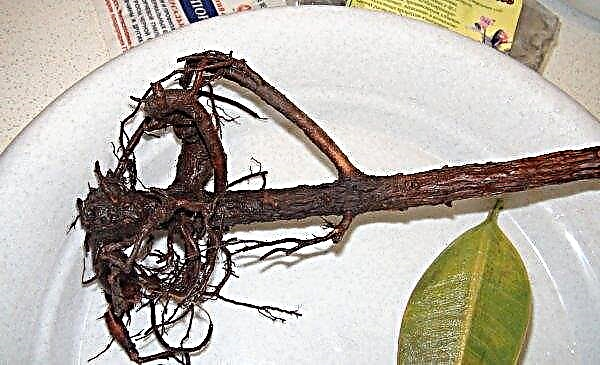Wrinkled rose - one of the brightest representatives of garden plants, fell in love with many for its incredible attractiveness and versatility. For many years, it acts as a decoration of landscapes and is used for medicinal and culinary purposes. Most flower growers know her under the names of "wild rose" or "rose of Rugosa" and appreciate her unpretentiousness in care and long plentiful flowering. Our article invites you to familiarize yourself with the different varieties and hybrids of the shrub, its use in landscape design, as well as tips on care and possible difficulties in growing.
Botanical description of the plant
Rosa Rugosa is an ornamental shrub reaching a height of about 2–2.5 m. In the natural environment of growth, it can be found in almost all countries of the Far East, but Japan is considered to be the birthplace of the plant. This unusual flower attracted the attention of domestic breeders only at the beginning of the 20th century, and now they tirelessly conduct various experiments to create new varieties and hybrids. Many mistakenly believe that a wrinkled rose is a hybrid, referring to the overly bright and unusual appearance of the plant, but this is a very common misconception. Rugosa is a creation of wildlife, deservedly appreciated by ancient people and widely used for decorating hedges and flower beds.
Many mistakenly believe that a wrinkled rose is a hybrid, referring to the overly bright and unusual appearance of the plant, but this is a very common misconception. Rugosa is a creation of wildlife, deservedly appreciated by ancient people and widely used for decorating hedges and flower beds.
The plant is characterized by many features, one of which is the formation of massive woody shoots that do not need pruning. Depending on the variety, they can be either needle-shaped or sickle-shaped and most often covered with thorns of different lengths and widths, but completely bare specimens can also be found. The shape of the bushes is also determined by their appearance - they can be either creeping or liana-shaped.
A wrinkled rose was named after its unusual foliage - it is tuberous from the outside, with characteristic notches directed to the bottom. In addition, the leaves attract attention with a rich dark green color, they are collected in 8-10 pieces on one petiole. The flowers are semi-double, rather large, usually located singly and can be a variety of shades of pink, yellow or white.  One flower usually has from 100 to 160 petals, which gives the plant incredible decorativeness. The root system is very well developed and can spread a considerable distance deep into the soil, which saves the plant from drought in the absence of watering. It is for this reason that it is recommended that Rugosa bushes be planted separately from other plants so that they do not suppress them with their powerful roots.
One flower usually has from 100 to 160 petals, which gives the plant incredible decorativeness. The root system is very well developed and can spread a considerable distance deep into the soil, which saves the plant from drought in the absence of watering. It is for this reason that it is recommended that Rugosa bushes be planted separately from other plants so that they do not suppress them with their powerful roots.
Flowering begins in May-June and continues until the first frost with a gradual discharge of flowers, which, however, does not affect the attractiveness and general appearance of the bush. Most hybrids exhibit repeated flowering in mid-autumn. After flowering, in place of fallen flowers, fruits form that acquire a bright orange color. They are widely used in cooking and medicine, collecting from one bush up to about 4 kg. The maximum weight of the fruits of Rugosa does not exceed 60 g.
Varieties and hybrids
Both foreign and domestic breeders bred a huge number of varieties and hybrids of Rugosa, characterized by high decorativeness. In addition, they are all united by a very pleasant sweetish aroma of flowers and their sizes, as well as the benefits of fruits, which are widely applicable in various areas of human life. Today, varieties of roses are very valuable and in demand, in the name of which there is the prefix "Grotendorst."
Check out other rose varieties:
This is the name of the famous Dutch rose grower who lived more than a century ago and was actively engaged in hybridization, and today the company Rosenberg und Grotendorst is named after him. So, the best varieties and hybrids are presented below:
- "F. J. Grothendorst, or Nelkenrose. To obtain this variety, the creators crossed little-known varieties of Rugosa Rubra and Polyanthus, and as a result, they created an incredibly beautiful specimen decorated with fancy bouquets of 10-30 small bright red flowers with a rich aroma. External resemblance to cloves served as the acquisition of a second name variety (Nelkenrose). In the conditions of our climate, this erect shrub can reach a height of 2 m. The leaves are glossy, spiky, dark green with a characteristic sheen. It blooms very plentifully and for a long time - all summer, and, like the other varieties, pleases with repeated flowering. The variety is also characterized by cold hardiness and extremely rarely freezes, even at record low temperatures.

- "Pink Grothendorst." No less popular version of the variety described above, characterized by an unusual pyramidal shape of a bush, the height of which does not exceed 1.5 m. The branches are very sprawling, and the shiny leaves are light green in color. The flowers are small, double, light pink, odorless, collected in inflorescences of 10-20 pieces. From other varieties, this variety is distinguished by the cut edges of the petals, which looks very unusual and decorative. Abundant and continuous flowering is observed throughout the summer and autumn. This variety is noteworthy for its high resistance to frost and disease, as well as its unpretentiousness in content and the duration of flowering.

- "Alba." A very unusual hybrid, small flowers of a bright white hue with golden stamens adorn it until the fall, having a light aroma. Foliage, rapidly yellowing to the onset of cold weather, is large enough and wrinkled, usually arranged in 10 pieces. The size of the bush is identical to the previous varieties, and according to the rest of the characteristics, “Alba” is in no way inferior to other Rugozy. The hybrid is winter-hardy enough, rarely susceptible to disease and tolerates the most adverse conditions. It blooms profusely from the beginning of summer to September. Thanks to the non-standard appearance, it looks very impressive as a hedge and in decorative shrubby compositions.
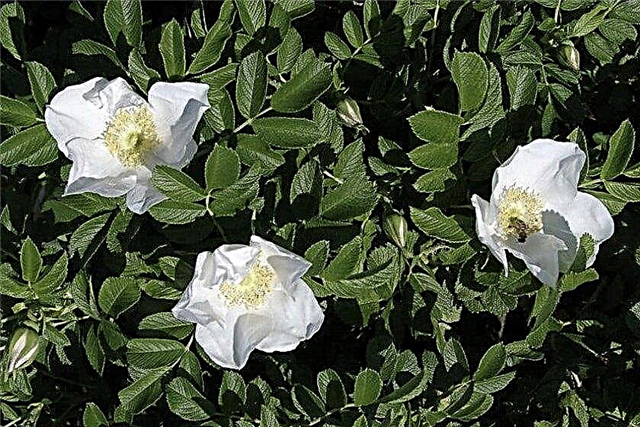
- "Grotendorst Suprim." Very bright variety of the initial variety "Grotendorst". It attracts attention with an exquisite raspberry shade of flowers, reminiscent of bouquets of carnations from afar. One stalk usually accounts for 10-15 pieces, forming small inflorescences and effectively stand out against the background of dark green shiny foliage. Spreading shrub up to 2 m high, flowering long and plentiful, able to re-repair in the fall. The hybrid is quite hardy, tolerates low temperatures and other adverse environmental conditions. Well suited for creating hedges or group plantings.

- Agnes. The plant has spiky woody shoots, large spikes and wrinkled shiny leaves of olive color with carved edges. This hybrid is characterized by many advantages - a pleasant fruity aroma, bright colors of flowers, ranging from a soft golden hue to ivory, and high resistance to disease. The flowers are very large - 10 cm in diameter, double, are located singly, and the petals are easily showered after rain or wind. The bush is straight and tall, usually not exceeding 2 m. Flowering begins very early and lasts no more than a month. Despite frost resistance, it quickly freezes without shelter.

- "Hansa." A very elegant rose variety of Rugosa, is very popular among flower growers, noting the fabulous beauty of flowers, the color of which is pure purple, and unpretentiousness in content. The bush is symmetrical, well leafy, ideal for creating hedges, but can also grow separately from other plants due to its small size. The flowers themselves are large, semi-double, with golden stamens and a rich aroma, noticeably differ from the other varieties in their shapelessness. Bright green wrinkled leaves in autumn are characterized by a change in color to yellow, orange and red shades. The abundant first flowering, lasting all summer, is followed by a repeated autumn wave. This hybrid, completely frost-resistant and resistant to all diseases, does not create any problems in care. After flowering, a large number of fleshy burgundy fruits are formed on the bush.

Landscape design application
A huge selection of different varieties of rose Rugosa allows it to be very profitably used in landscape design, especially given its ability to clean the surrounding air from pollution. The shrub found the most active application in creating an impassable hedge, which additionally serves to protect the site from uninvited guests, and the formation of fruits after flowering makes it possible to enjoy such a hedge all year round, without making much effort to maintain it.
Rugosa roses are planted as independent plants. The range of applications of wrinkled roses as a decoration for various places of rest is also very wide, and Rugosa is also the favorite of landscape designers who prefer to create numerous ethno compositions from it, combining it with other plants.
The most profitable and interesting combinations of rose Rugosa with juniper, any coniferous or deciduous tree, spirea and even stones - such compositions are called "rockeries". In addition to decorative purposes, the shrub also serves as an excellent environmental and natural barrier, since it reliably strengthens coasts, ravines and cleans the air in the industrial zone.
Planting seedlings in the open ground
Even novice and inexperienced flower growers can cope with the planting of a wrinkled rose. Entering the category of plants that are completely undemanding to the soil and place of growth, it also easily tolerates a sharp change in temperature and drought, but in order to get the most beautiful and saturated color of flowers, it is better to take care of creating the most optimal conditions for its growth and development.
Seat selection
A wrinkled rose is an undemanding plant, but it feels most comfortable in bright sunlight, therefore a well-lit and sheltered from the wind slope of the south or west side is suitable.
Soil moisture for Rugosa roses is also not a decisive factor, but for the fastest growth and development it is better to use a substrate with a low level of acidity.  When planting a shrub in alkaline soil, it will be necessary to regularly apply mineral fertilizers, since such a soil composition will not be able to fully feed the plant.
When planting a shrub in alkaline soil, it will be necessary to regularly apply mineral fertilizers, since such a soil composition will not be able to fully feed the plant.
Important! Despite the fact that the leaves of Rugosa are quite dense and hard, they are very easy to burn, so care for the rose with the help of chemicals is carried out with extreme caution.
Scheme and Depth
The most suitable time for planting the plant is considered to be early spring, until the buds open, but planting is also acceptable in the fall, if the characteristics of the variety allow. Depending on the purpose of the procedure, the distance between the seedlings can be different:
- if we are talking about creating a hedge, in this case it is necessary to make an interval of at least 70 cm;
- if the bush is planned to be planted alone, it is recommended to build a vertical fence, for example, with sheets of roofing iron, maintaining a distance between plantings of 2 m;
- group plantings of Rugosa rose with other plants require a mandatory distance of 1.5 m.
 The depth of the hole is usually 40-50 cm. Before the planting process itself, the soil will need to be well fertilized by introducing a bucket of peat or humus into one hole. To avoid drying out, immediately after planting the seedlings, the substrate is abundantly watered and mulched, and the shoots are necessarily shortened by one third. After all the necessary procedures, the seedlings will need to be shaded from the sun for the first few weeks of rooting in order to protect from burns on the leaves.
The depth of the hole is usually 40-50 cm. Before the planting process itself, the soil will need to be well fertilized by introducing a bucket of peat or humus into one hole. To avoid drying out, immediately after planting the seedlings, the substrate is abundantly watered and mulched, and the shoots are necessarily shortened by one third. After all the necessary procedures, the seedlings will need to be shaded from the sun for the first few weeks of rooting in order to protect from burns on the leaves.Care Tips
Rosa Rugosa - the plant is absolutely capricious and does not require significant expenditures of time and effort. One of the many advantages of the bush is also its ability to fully grow and develop without transplanting for 30 years, but for this you need to follow simple rules. We consider them further in detail.
Watering
Rugosa, because of its heat resistance, does not like excess moisture, so the plant needs to be watered with a rare, but plentiful - at least 10 liters per bush. The most acceptable option is watering the bush only once a week, while the substrate should be drained and moderately moist. In total, there are about 4–5 irrigations per season, however, if the fruiting period is in arid, dry weather, it is recommended that you take this procedure all the same. After the rose reaches 7–8 years, its roots will settle so firmly in the soil and go deep that Rugosa is quite capable of doing without moisture for about a month.
In total, there are about 4–5 irrigations per season, however, if the fruiting period is in arid, dry weather, it is recommended that you take this procedure all the same. After the rose reaches 7–8 years, its roots will settle so firmly in the soil and go deep that Rugosa is quite capable of doing without moisture for about a month.
Did you know? The oldest rose on the planet is over 1000 years old, and it grows in Germany, at the cathedral in Hildesheim. Moreover, despite the damage during the war years, the plant survived and began to grow with renewed vigor, sprouting from the remaining root.
Fertilizer application
Wrinkled rose fertilizer will be needed only in the third year of life, and before that it is not recommended to overload the plant with various nutrient components. In specialized stores, you can buy ready-made mineral fertilizers labeled “for roses,” but the greatest nutritional value for the plant is urea, which is applied every spring at a rate of 40 g per 1 m². After the fruiting of the bush begins, the feeding scheme changes slightly and is done like this:
- every few years, the bush is necessarily fertilized with organic components - humus, mullein or bird droppings (15 kg per 1 m²);
- mineral fertilizers are applied with the same frequency, namely 60 g of superphosphate and 10 g of potassium salt.
Video: Rose Feeding Calendar
Loosening and weed control
To increase life expectancy and reduce the risk of diseases of the rose Rugosa, it is necessary to regularly eliminate weeds and loosen the soil around the bush. Usually this procedure is carried out at the end of May, then stops for some time to exclude further enhanced plant growth.
 Loosening allows you to saturate the soil with a large amount of oxygen and heat, and even significantly reduce water costs, since the loosened substrate saves moisture perfectly.
Loosening allows you to saturate the soil with a large amount of oxygen and heat, and even significantly reduce water costs, since the loosened substrate saves moisture perfectly.
Particular attention should be paid to this process in the heat, immediately after watering. It will also be useful to loosen the substrate after prolonged rains, after it has covered with a crust. However, it should be remembered that too deep loosening is detrimental to the rose, so 10-15 cm is a suitable depth. It is also recommended to protect the wrinkled rose from other, weaker plants.
Pruning
Pruning a bush in order to rejuvenate it is a mandatory procedure for the care of wrinkled roses. Rugosa is usually cut off a few weeks before a cold snap or in the spring by the time the buds open.As in the case of top dressing, they begin to conduct this event in the third year after planting. It includes the removal of broken and lying on the ground branches, as well as root offspring, far removed from the bush.
The surviving shoots are pruned at a height of 15 cm and leave about 6-7 healthy branches. With the formation of new shoots, they are periodically shortened to the fourth part, as soon as their growth exceeds 80 cm. This will ensure a better development of the branches and accelerate the fruiting process. Subsequent execution of the procedure boils down to the regular removal of unproductive, weak and painful branches, usually reaching the age of 6–7 years. It is very important to regulate the number of full-fledged, well-developed branches during the shrub care, which an adult plant should have no more than 20. Subsequently, it is recommended to replace perennial branches with 3-4 young shoots. Such a simple technique will allow the rose to bloom more abundantly and continuously.
It is very important to regulate the number of full-fledged, well-developed branches during the shrub care, which an adult plant should have no more than 20. Subsequently, it is recommended to replace perennial branches with 3-4 young shoots. Such a simple technique will allow the rose to bloom more abundantly and continuously.
Important! The pruning procedure must be carried out by pruners and gloves, be sure to not hurt your hands on sharp thorns.
Wintering
Rugosa is characterized by incredible winter hardiness, which allows it to survive record low temperatures, so in most cases it does not need winter shelter. In just a few varieties, during prolonged frosts, the aboveground parts can freeze, which in this case provides shelter with cellophane. In general, it is quite simple to mulch the soil under the bush with sawdust.
Possible growing difficulties
Almost all varieties of Rugosa, in addition to frost resistance, are also resistant to diseases and pests, however, if the defeat does occur, it is solely due to non-compliance with the cultivation agricultural technique. The most common pests attacking the plant are a spider mite, a leaf moth and a sawfly. They appear at the time of the greatest weakening of the plant from a lack of lighting, watering and top dressing.
Preventive measures to prevent insects are as follows:
- regular sanitary pruning;
- destruction of plant waste and rotten fruit in the autumn;
- conducting a planned digging around the bush and a thorough inspection of the plant for the presence of clutches of pest eggs;
- treatment of roses with chemical preparations for preventive purposes - carried out 1% Bordeaux liquid twice: before frost and in early spring until buds open.
Rugosa is also not insured against diseases, the signs of which can be rapid yellowing and falling of leaves or the appearance of brown spots on them for no apparent reason. All these are characteristic symptoms of fungal infections such as powdery mildew, gray rot and rust. The causes of their occurrence are most often due to excess moisture, and usually when the grower normalizes the irrigation process, the situation stabilizes. However, in critical conditions it is still recommended to resort to the use of fungicides. The lack of timely measures is fraught with the rapid spread of the disease and death of the plant, so do not delay treatment. Often, flower growers note the rapid decline of flowers and deformation, and then the drying of the fruits of a wrinkled rose. In this case, the cause is a lack of nutrients. The solution to the problem is to simply fertilize the shrub, to add peat or humus to the soil.
Often, flower growers note the rapid decline of flowers and deformation, and then the drying of the fruits of a wrinkled rose. In this case, the cause is a lack of nutrients. The solution to the problem is to simply fertilize the shrub, to add peat or humus to the soil.
Did you know? The aroma of roses is one of the strongest antidepressants.
The unpretentiousness and widespread use of wrinkled roses make it possible to use it advantageously for both decorative, culinary, and even medical purposes, and the stability that most plants can envy is only one of the most advantages of the Rugosa rose.







